ROBERT LEA FROM SPACE
The comet C/2022 E3 (ZTF) could be bright enough to be spotted with the naked eye as it passes the sun and Earth at the end of the first month of 2023.
At the start of 2023 Earth will be visited by a newly discovered comet that may just be bright enough to be spotted with the naked eye.
The comet, named C/2022 E3 (ZTF), is currently passing through the inner solar system. It will make its closest approach to the sun, or perihelion, on Jan. 12, and will then whip past Earth making its closest passage of our planet, its perigee, between Feb. 1 and Feb. 2.
If the comet continues to brighten as it currently is, it could be visible in dark skies with the naked eye. This is difficult to predict for comets, but even if C/2022 E3 (ZTF) does fade it should still be visible with binoculars or a telescope for a number of days around its close approach.
According to NASA(opens in new tab), observers in the Northern Hemisphere will be able to find the comet in the morning sky, as it moves in the direction of the northwest during January. C/2022 E3 (ZTF) will become visible for observers in the Southern Hemisphere in early February 2023.
Observers should look for C/2022 E3 (ZTF) when the moon is dim in the sky, with the new moon on Jan. 21 offering such an opportunity, weather permitting. According to the website Starlust(opens in new tab), the comet will be in the Camelopardalis constellation during its close approach.
If you’re hoping to observe C/2022 E3 (ZTF), our guides for the best telescopes and best binoculars are a great place to start. If you’re looking to snap photos of the night sky, check out our guide on how to photograph the moon, as well our best cameras for astrophotography and best lenses for astrophotography.
According to NASA Jet Propulsion Laboratory (JPL), the comet has a period of around 50,000 years. This means that prior to it coming to within around 100 million miles (160 million kilometers) of the sun on Jan. 12 and 26 million miles (42 million kilometers) of Earth on Feb. 2, the last time it came so close was during the Upper Paleolithic period on Earth.



